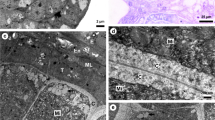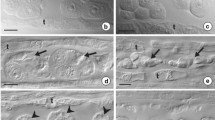Abstract
In safflower, the anther wall at maturity consists of a single epidermis, an endothecium, a middle layer and the tapetum. The tapetum consists mainly of a single layer of cells. However, this single-layer appearance is punctuated by loci having ‘two-celled’ groupings due to additional periclinal divisions in some tapetal cells. Meiotic division in microsporocytes gives rise to tetrads of microspores. The primexine is formed around the protoplasts of microspores while they are still enveloped within the callose wall. Just prior to microgametogenesis, the microspores enlarge through the process of vacuolation, and the exine wall pattern becomes established. Microgametogenesis results in the formation of 3-celled pollen grains. The two elongated sperm cells appear to be connected. The exine wall is highly sculptured with a distinct tectum, columellae, a foot layer, an endexine and a thin intine. Similar to other members of the Asteraceae family, the tapetum is of the invasive type. The most novel finding of this study is that in addition to the presence of invasive tapetal cells, a small population of ‘non-invasive’ tapetal cells is also present. The tapetal cells next to the anther locules in direct contact with the microspores become invasive and start to grow into the space between developing microspores. These tapetal cells synthesize tryphine and eventually degenerate at the time of gametogenesis releasing their content into the anther locules. A smaller population of non-invasive tapetal cells is formed as a result of periclinal divisions at the time of tapetum differentiation. These cells are not exposed to the anther locules until the degeneration of the invasive tapetal cells. The non-invasive tapetal cells have a different cell fate as they synthesize pollenkitt. This material is responsible for allowing some pollen grains to adhere to each other and to the anther wall after anther dehiscence. This observation explains the out-crossing ability of Carthamus species and varieties in nature.





Similar content being viewed by others
References
Blackmore S, Wortley AH, Skvarla JJ, Rowley JR (2007) Pollen wall development in flowering plants. New Phytol 174:483–498
Classen CE (1950) Natural and controlled crossing in safflower (Carthamus tinctorius L.). Agron J 42:381–384
Coleman AW, Goff LJ (1985) Applications of fluorochromes to pollen biology. I. Mithramycin and 4’, 6-diamidino-2-phenylindole (DAPI) as vital stains for quantitation of nuclear DNA. Stain Tech 60:145–154
Dickinson HG, Lewis D (1973) The formation of the tryphine coating the pollen grains of Raphanus, and its properties relating to the self-incompatibility system. Proc R Soc Lond B 184:149–165
Dumas C, Knox RB, McConchie CA, Russell SD (1984) Emerging physiological concepts in fertilization. Whats New Plant Physiol 15:17–20
Ekin Z (2005) Resurgence of safflower (Carthamus tinctorius L.) utilization: a global view. J Agron 4:83–87
Furness CA (2008) A review of the distribution of plasmodial and invasive tapeta in eudicots. Int J Plant Sci 169:207–223
Gyulai J (1996) Market outlook for safflower. In: Mundel HH, Braun J, Daniels C (eds) Proceedings of North American Safflower Conference, Great Falls, Montana, January 17–17, 1996. Agriculture and Agri-Food Canada, Lethbridge, p 15
Horner HT (1977) A comparative light- and electron-microscopic study of microsporogenesis in male-fertile and cytoplasmic male-sterile sunflower (Helianthus annuus). Am J Bot 64:745–759
Horner HT, Pearson CB (1978) Pollen wall and aperture development in Helianthus annuus (Compositae: Heliantheae). Am J Bot 65:293–309
Kadam BS, Patankar VK (1942) Natural cross-pollination in safflower. Ind J Genet Plant Breed 2:69–70
Knowles PF (1969) Centers of plant diversity and conservation of crop germplasm: Safflower. Econ Bot 23:324–329
Knowles PF (1989) Safflower. In: Robbelen G, Downey RK, Ashri A (eds) Oil crops of the world. McGraw-Hill, New York, pp 363–374
Lersten NR (2004) Flowering plant embryology. Blackwell Publishing, Ames
McConchie CA, Hough T, Knox RB (1987) Ultrastructural analysis of the sperm cells of mature pollen of maize, Zea mays. Protoplasma 139:9–19
Mogensen HL (1992) The male germ unit: concept, composition, and significance. Int Rev Cytol 140:129–147
O’Brien TP, McCully ME (1981) The study of plant structure: principles and selected methods. Termarcarphi Pty. Ltd, Melbourne, p 344
Pacini E (2010) Relationships between tapetum, locules, and pollen during development. Int J Plant Sci 17:1–11
Pacini E, Franchi GG (1992) Diversification and evolution of the tapetum. In: Blackmore S, Barnes SH (eds) Pollen and spores, systematics association special volume no. 44. Clarendon Press, Oxford, pp 301–316
Pacini E, Hesse M (2005) Pollenkitt–its composition, forms and functions. Flora 200:399–415
Parish RW, Li SF (2010) Death of a tapetum: a programme of developmental altruism. Plant Sci 178:73–89
Peirce JR (1992) The biology of Australian weeds 23. Carthamus lanatus L. Plant Protect Quart 7:86–95
Poehlman JM, Borthakur D (1969) Breeding Asian field crops: with special reference to crops of India. Oxford and IBH Publishing Co., New Delhi
Prasad BR, Khadeer MA, Seeta P, Anwar SY (1991) In vitro induction of androgenic haploids in safflower (Carthamus tinctorius L.). Plant Cell Rep 10:48–51
Southworth D, Russell SD (2001) Male gametogenesis. In: Bhojwani SS, Soh WY (eds) Current trends in the embryology of Angiosperms. Kluwer Academic Publishers, Dordrecht, pp 1–16
Srinivas CVS, Praveena B, Nagaraj G (1999) Safflower petals: a source of gamma linolenic acid. Plant Food Human Nutr 54:89–92
Twell D (2002) Pollen developmental biology. In: O’Neill SD, Roberts JA (eds) Plant reproduction, annual plant reviews, vol 6. Sheffield Academic Press, Sheffield, UK, pp 86–153
Yeung EC (1984) Histological and histochemical staining procedures. In: Vasil IK (ed) Cell culture and somatic cell genetics of plants, vol 1. Academic Press, Orlando, pp 689–697
Yeung EC (1999) The use of histology in the study of plant tissue culture systems—some practical comments. In Vitro Cell Dev Biol Plant 35:137–143
Yeung EC (2002) The canola microspore-derived embryo as a model system to study developmental processes in plants. J Plant Biol 45:119–133
Acknowledgments
The authors are grateful to Lori Schmidt, Supervisor, Plant Growth Facilities at SemBioSys, for growing all the safflower plants used during the course of this project. This research is supported in part by a University of Calgary research grant and a NSERC Discovery grant to E. C. Yeung.
Author information
Authors and Affiliations
Corresponding author
Additional information
Communicated by Scott Russell.
Rights and permissions
About this article
Cite this article
Yeung, E.C., Oinam, G.S., Yeung, S.S. et al. Anther, pollen and tapetum development in safflower, Carthamus tinctorius L. Sex Plant Reprod 24, 307–317 (2011). https://doi.org/10.1007/s00497-011-0168-x
Received:
Accepted:
Published:
Issue Date:
DOI: https://doi.org/10.1007/s00497-011-0168-x




